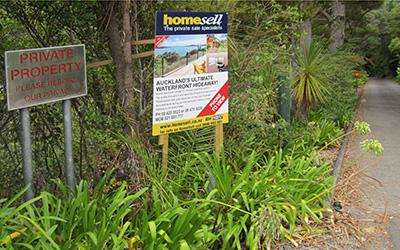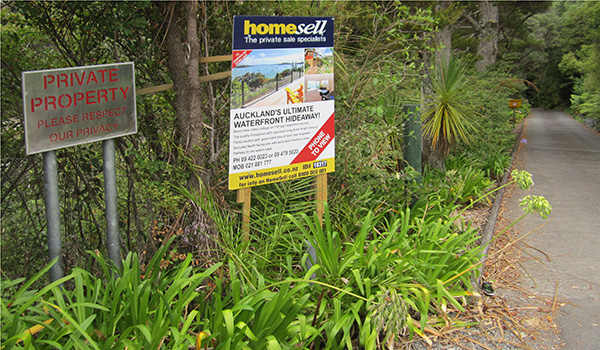Resolving outstanding practical problem


Built to Last: Constructed from heavy gauge stainless steel and erected prior to the High Court decision in favour of the public’s reasonable use of this accessway between Jamieson Road and the foreshore, eleven years on Auckland Council acknowledges that it is now time to address its disinforming message. image Cimino Cole
It’s nine years six weeks since it was signed. So there is every likelihood that, by the tenth anniversary of the signing of heads of agreement, what Justice Rhys Harrison described in his declaratory judgement as the outstanding practical problems will indeed have been resolved:
I trust that, with this determination of the contentious legal issue, the parties are able to work constructively together to resolve outstanding practical problems.
To address some of those outstanding practicle problems, a heads of agreement was negotiated by the community with the support of Rodney District Council, and 42 property titles were voluntarily changed, formalising the as-built route of the access way between the end of Jamieson Bay Road and the esplanade reserve, thus removing the last impediment to the public’s reasonable enjoyment of its legal right of way.
The sole contentious outstanding issue is the sign at the Jamieson Bay Road terminus of the access way that was erected prior to the 2002 High Court decision, with the objective of discouraging public use of the rights of way.
The challenge now to devise a sign that advises members of the public of their right to the reasonable use of the access way, without generating unnecessary vehicular traffic. Presumably, the starting point is to indicate that, at the esplanade reserve, there is only limited parking, and that neither trailer parking nor overnight parking is permitted.
To that end, Auckland Council has called a public meeting in the Mahurangi West Hall at 6 pm on Thursday 5 December, and has specifically invited members of Mahurangi Action Incorporated (previously Friends of the Mahurangi Incorporated) and the Mahurangi Improvement Society.
Appendix A of the heads of agreement recorded the history of the access way, in the knowledge that parties, particularly the Rodney District Council, repeatedly misunderstood what had been agreed to, in 1957, by the Crown, the council and the subdivider. The hope was that by it being concisely recorded, the same misapprehensions could be avoided, and that the community could put the access way’s history of contentious use behind it.
If, on Thursday week evening, a consensus emerges as to an appropriate sign, a line will have finally been draw under a sorry, 56-year-old, saga.
Update
Notification of the public meeting generated discussion of another outstanding element of the negotiated settlement:
Reserve Walkway
- In order to assist with a separation of pedestrian and vehicular Access Way traffic, the Council will provide enhanced pedestrian access between the Road Head and the Foreshore, via the Reserve in part by upgrading a section of the existing track (shown coloured red on the attached plan marked “D”) and in part by developing new sections of lesser gradient and maintain the walkway (“the Walkway”) to that enhanced standard. It is acknowledged that geotechnical and slope stability issues exist in this area and potential land movement may seriously impact on the quality and scope of this access.
Because a further landslip occurred after the heads of agreement was signed, it is now necessary for a feasibility study of the proposed upgraded esplanade reserve walkway to be undertaken. To help resolve the remaining outstanding issues, it is likely that a new working party will be formed, with representatives of Mahurangi Action, Mahurangi Improvement Society, and Auckland Council.
Appendix A
- Following the enactment by the New Zealand Parliament of the Subdivision in Counties Act, 1946, property holders of informal subdivisions were required to prepare scheme plans. Accordingly, George Gilbert Jamieson (“the Subdivider”) was required to prepare and deposit a scheme plan (“the Scheme Plan”, annexed to this Agreement marked “A”) in respect to the 12 (by 1957) leasehold baches (elementary vacation dwellings) on his 16-acre property at Jamieson Bay, Mahurangi Harbour. [Plan 6037 lodged 25 July 1957 indicates extant leasehold baches]
- Sometime prior to 1957 the Council declined to accept for dedication the road (“the Access Way”) between what is now the terminus of Jamieson Road (“the Road Head”) and the land adjacent the boat ramp then at Jamieson Bay (“the Foreshore”). The reason given by the County Engineer for this decision was that part of the road went “through steep country subject to slips”. The position was pragmatic: it is understood that it was usual for bach holders to leave vehicles in an area uphill from the Road Head (as illustrated subsequently by the Council’s requirement for the Subdivider to develop the area of road reserve adjacent Lots 5, 6 & 8 for that purpose). The practice probably reflected the extreme gradient of the initial section of the descent, which was subsequently eliminated by the subdivision roading. [Comments of Local Authority, County Clerk 20 October 1956 (year probable but indistinct).]
- In 1957, a conference was held in Warkworth between the Crown, the Council and the Subdivider (represented by his surveyor) and agreement reached on a number of issues outstanding including that the Scheme Plan should “reserve rights of way in favour of every lot in the subdivision, including lot 13, Esplanade Reserve, to provide access to the foreshore”. [Letter by J D Mollard, T Tripp Andrews & Partners registered surveyors 6 November 1957 recording decisions of conference 29 October 1957.]
- The scheme plan deposited created two dedicated roads (Barr and Jamieson roads) and 42 residential lots (“the Lots”). Further, the Scheme Plan provided:
- That the Subdivider vest the land adjacent to the foreshore in the Crown as an esplanade reserve (Lot 13 of the subdivision, “the Reserve”, now vested in the Council).
- For right of way easements to be created favouring all Lots in respect to the Access Way including those 14 Lots that required use of the Access Way for primary access (i.e. those without practicable direct access to either Barr or Jamieson Road).
- For right of way easements to be created (by Transfer 633302, “the Original Easement”) over parts of the 12 servient tenement Lots effected by the Access Way.
- The access way delineated in the Original Easement possibly did not entirely correspond with the extant carriageway. In any event, parts of the carriageway, as subsequently progressively upgraded by the Improvement Society, are on private land not subject to the Original Easement (“the Access Discrepancy“).
- The self-help upgrading and maintenance of the Access Way by the Lot holders, combined with their enjoyment of specific right of way easements to it, lead to a misapprehension to prevail that the public enjoyed no entitlement to the Access Way in respect to the Reserve. Some actions and statements by the Council reinforced that misapprehension. [The Council advised mooring holder E van Duyn 23 June 1986 access way was “substantially on private property”; Letter by Council harbour master P Olsen 15 December 2000 stating “esplanade reserve for use of affected property holders only”.]
- The majority of the residential lot holders (“the Applicants”, the membership of the Improvement Society) applied to the High Court, Auckland (“the Court”), in 2001, for declarations against the Council for the purpose of establishing that the public enjoyed no entitlement to the Access Way in respect to the Reserve. [Harb Trading Limited & Others v Rodney District Council, M No. 794-SD/01]
- Friends of the Mahurangi applied to the Court to be joined to the proceeding as second defendant to the Council. The application was allowed.
- The court dismissed the Applicants’ prayer for declaratory relief but held that the Original Easement did not create a public roadway nor give unrestricted rights of use to the general public. The Court trusted that with its determination of the contentious legal issue, the parties (“the Parties”) would work constructively together to resolve outstanding practical problems involved with public use of the Access Way (the “Resolution”).
- Following dismissal of the Court application, the Council engaged separately with the Improvement Society and Friends of the Mahurangi in respect to the Resolution, mindful of: the Court’s observation that the Original Easement did not create a public roadway nor give unrestricted rights of use to the general public; of the Access Discrepancy; of traffic engineers’ reports that concluded the access way should have restrictions on use due to traffic safety issues; of the small functional area of the Reserve; and that it must, under the Resource Management Act, consider enhancing public access to and along the foreshore as a matter of national importance. To that end, the Council established the Jamieson Bay Issues Working Party.
- With the blessing of the Council, Friends of the Mahurangi and the Improvement Society, in 2003, negotiated directly resulting in those two parties agreeing on a conceptual Resolution. With the addition of a formal Access Discrepancy rectification component (“the Rectification”), desired by the Council, the Parties reached agreement on the structure of the Resolution.
